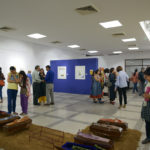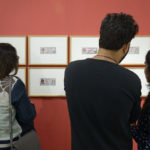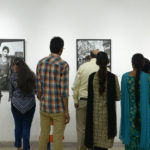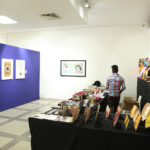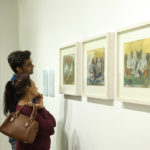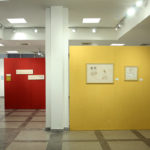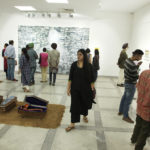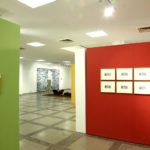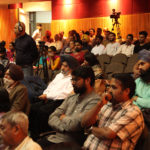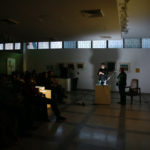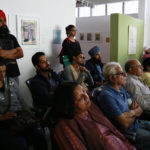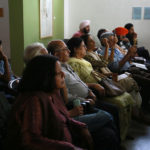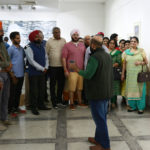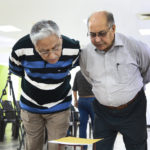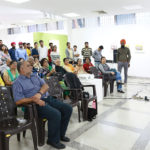Dissensus
International Art Exhibition
Oct 26 – Nov 12, 2017
Gallery, Punjab Lalit Kala Akademi,
Chandigarh / In collaboration with
Gallery LATTITUDE 28
Fay Ku / Taiwan
Gazi Nafis Ahmed / Bangladesh
Hit Man Gurung / Nepal
Khadim Ali / Afghanistan
Neda Tavallaee / Iran
Priyanka D’Souza / India
Veer Munshi / India
Waseem Ahmed / Pakistan
Bhavna Kakar – Curator / India
These are stories of us, narratives that
emerge from the partitioning of places,
crisis of identity, feeling of impermanence,
displacement, violence, aggression, inequality,
of our failings as human beings.
Art, they say, is a reflection of our times
and ‘Dissensus’ brought together 60
works by eight artists from 7 countries
who have been witness to the political
and identity crises in regions of on-going
conflict — Nepal, Afghanistan, Iran,
Taiwan, Bangladesh, Kashmir in India,
and Pakistan. Presented by Punjab
Lalit Kala Akademi in collaboration with
Gallery Latitude 28, New Delhi, the artists
represented in this exhibition were Fay
Ku, Gazi Nafis Ahmed, Hit Man Gurung,
Khadim Ali, Neda Tavallaee , Priyanka
D’Souza, Veer Munshi and Waseem Ahmed.
The exhibition has been curated by Bhavna
Kakar, Delhi-based curator, publisher
and editor of the prestigious art journal
Take on Art.
The issues that are of immediate concern
to the artists range from gender, territorial
dispute, anxieties regarding cultural
annihilation and ethnic marginalization,
as the artists look at immediate, everyday
contexts, and markers to create quiet acts
of dissent away from the central, political
stage. The works are intimate testimonies
and observations, as several artists
find a language in the subtlety of the
miniature tradition to voice their politics.
As part of Dissensus, the audience had a
chance to view works by Priyanka D’Souza,
a young MSU Baroda trained artist, who
responds to deeply political and social
contemporary issues through a work that
is inspired by Mughal miniatures. Also
presented were works by Australia-based
artist Khadim Ali, whose work is based on
current social and political issues and the
incidents in surroundings where religion is
the base of every conflict. ‘Dissensus’ also
marked the first India exhibition for Iranian
artist Neda Tavallaee, who addresses her
feminist concerns through the language
of Persian miniatures, as the Taiwan-born,
New York-based artist Fay Ku collages
an eclectic account of personal identity
through multi-layered tableaus. The exhibition
also showcased Bangladeshi activist
artist Gazi Nafis Ahmed’s black and white
photographs from the series ‘Puran Dhaka’,
documenting precarious communities in
Bangladesh. Hit Man Gurung’s work ‘We
are in war without enemies…’ is from the
series, ‘This is My Home, My Land and My
Country…’, Dedicated to the earthquake
survivors of Nepal who lost their home
and beloved ones in 2015, with thousands
of families still living in poor conditions
and temporary shelters.
A special Art Walk was lead by contemporary artist
Veer Munshi, whose work was also on display as
part of the exhibition DISSENSUS.
Kashmir-born and Delhi-based Munshi took viewers
through the exhibition discussing the social, cultural
and political aspects of the works on display.
Munshi talked about the many issues that the
artists represented in this exhibition, express in
their work, in context with conflict, with the testimonies
and observations employing the aesthetic
to develop micro-poetics of the stakes borne by
civilians, whose concerns are overlooked in media
narratives driven by political figureheads, capital
and diplomatic ties. He mentioned how scale and
detail evoke the marginal locations of the themes,
and the multitude that is united in these narratives.
Going into the many aspects of the techniques,
treatments and philosophy of the art works on
display, Munshi emphasised how religion can never
lead to progress and development. “Culture and
art can lead to change and the exhibition here
brings many harsh realities of our times closer to
common people.” He added how he views himself
as an activist, without being political and how artists
must follow the middle path, the humanitarian one.
Munshi firmly believes that while talking about
conflict zone, it is important to give a chance to
everyone to speak for each person is true in his /
her experience and expression.
Veer as he is lovingly known among his friends
gave another slide presentation of his art works
along with two short video films.



